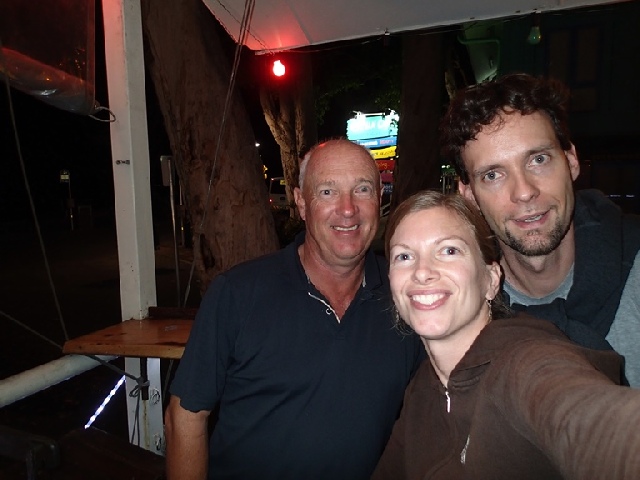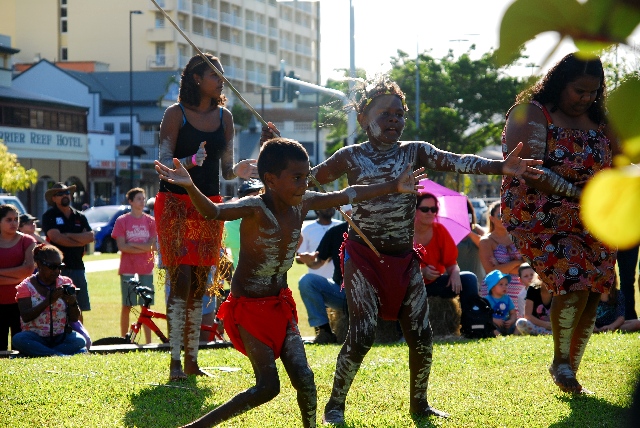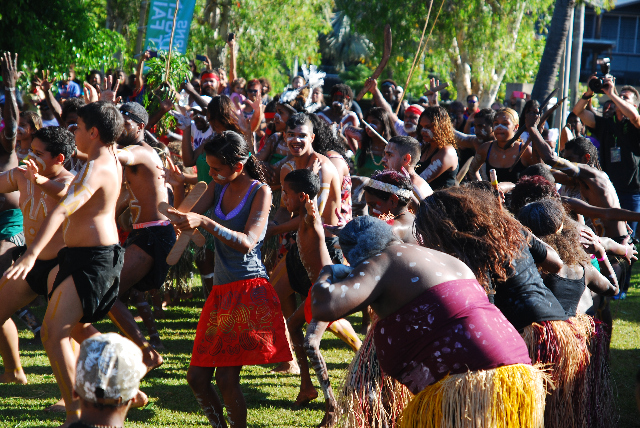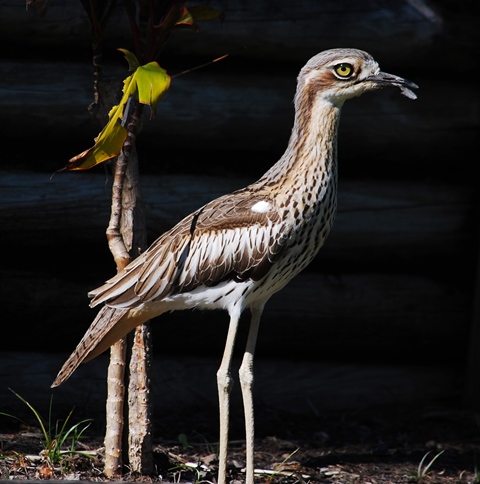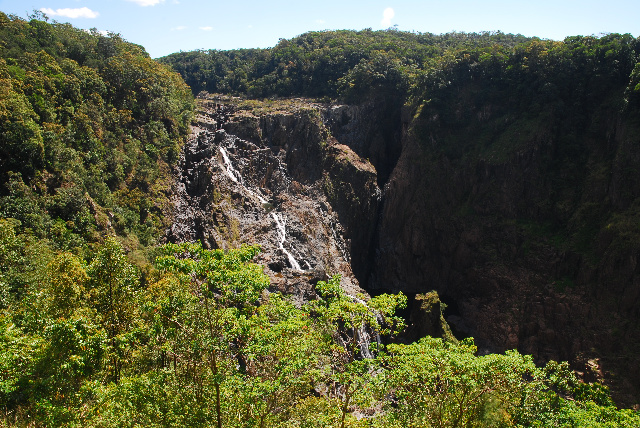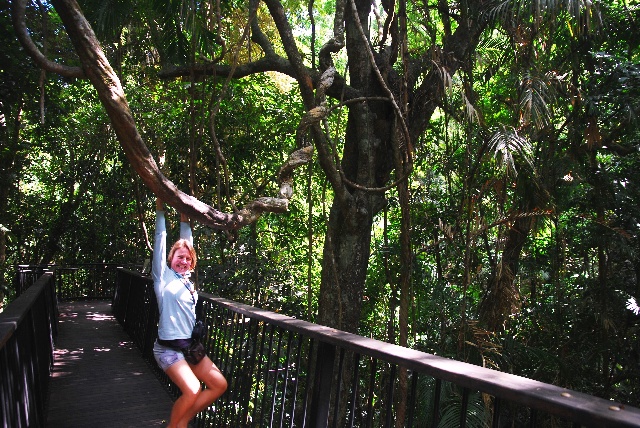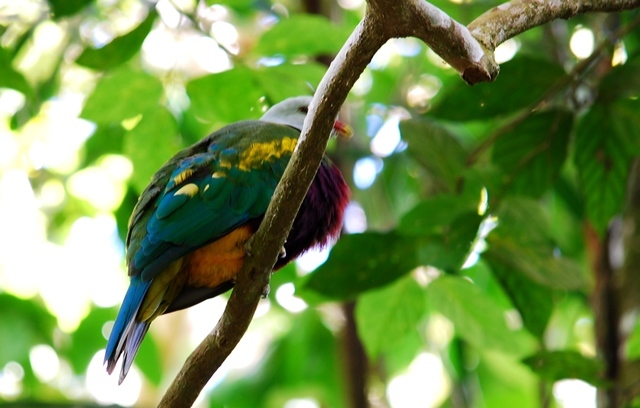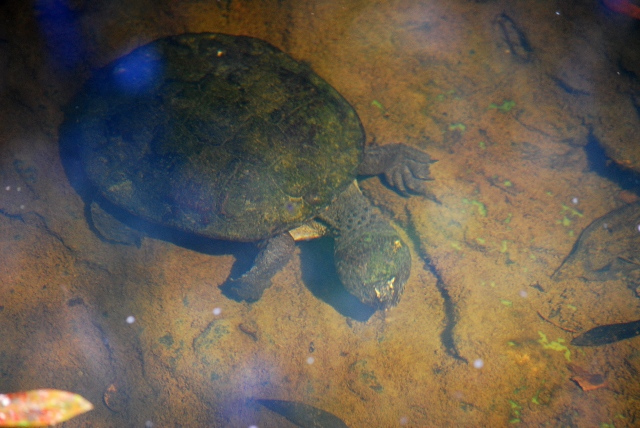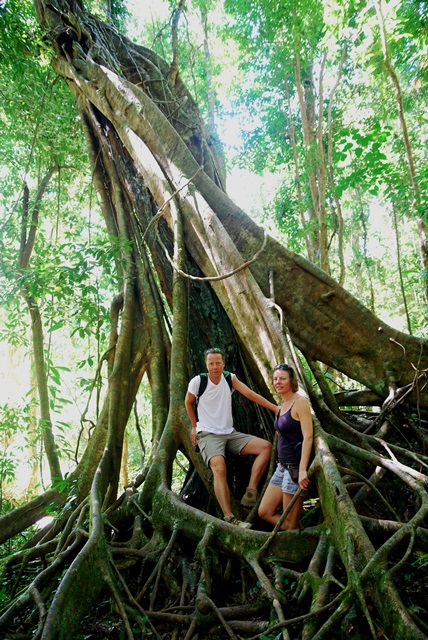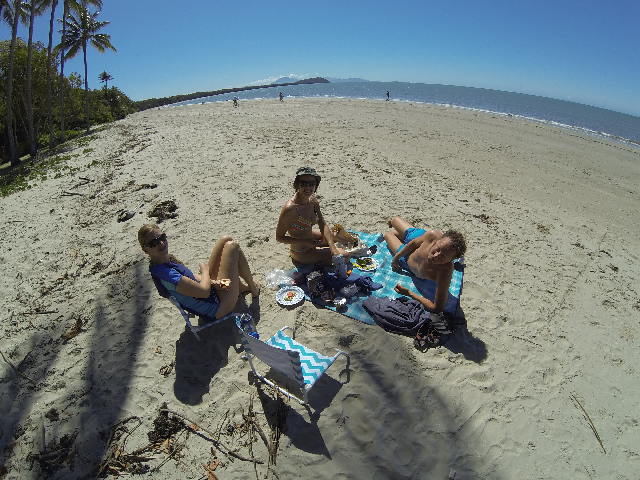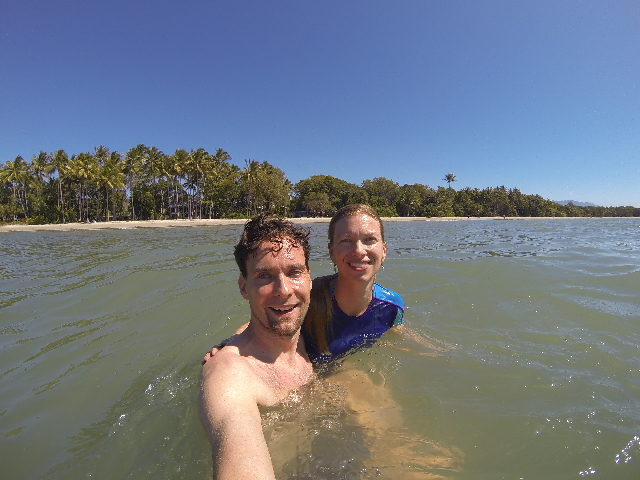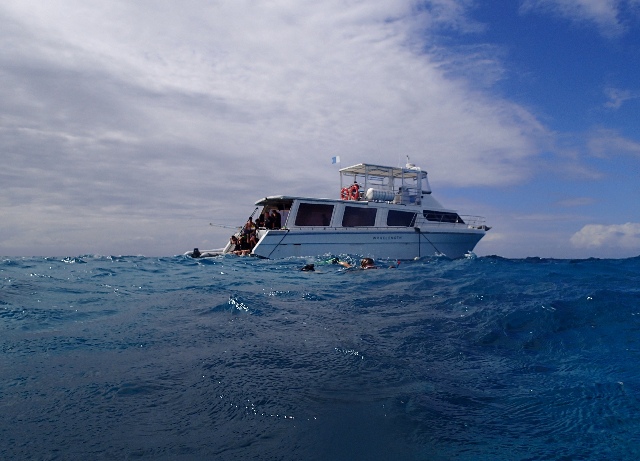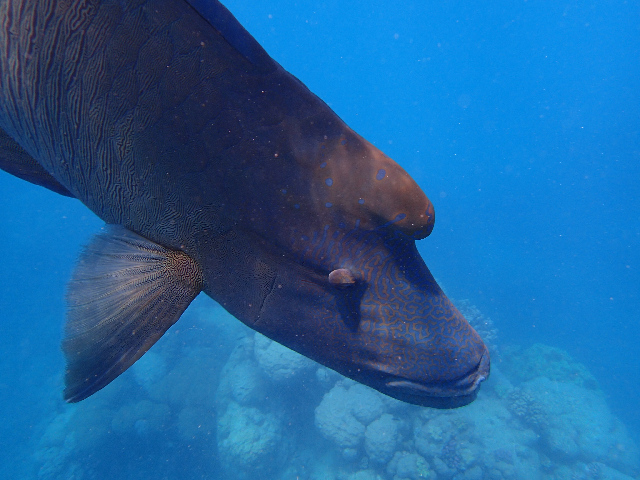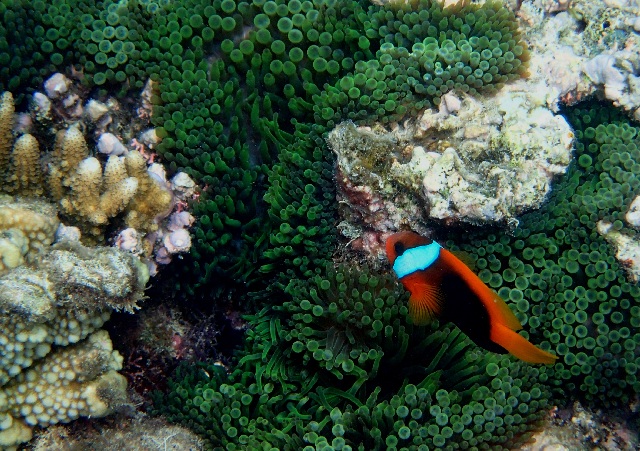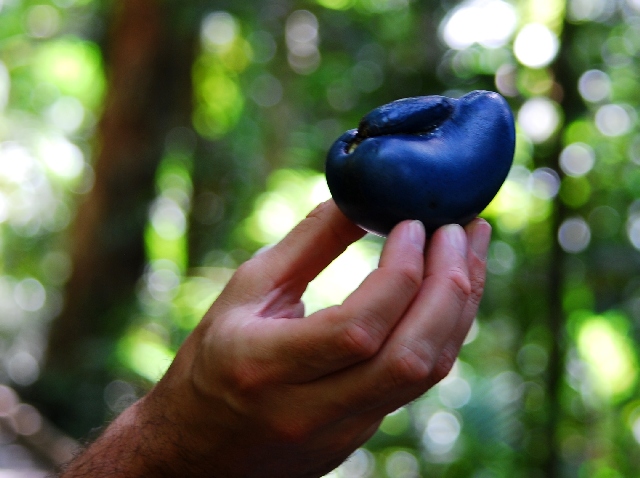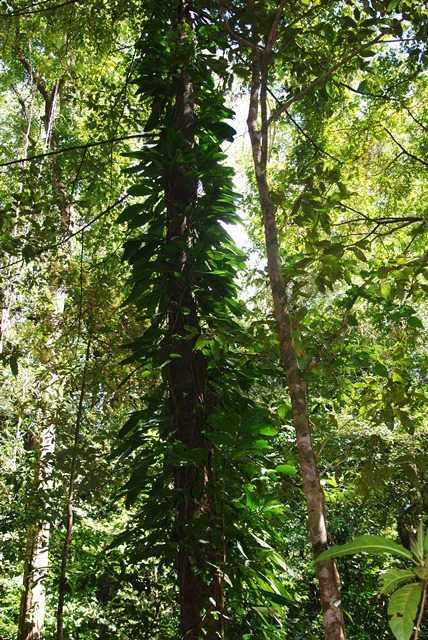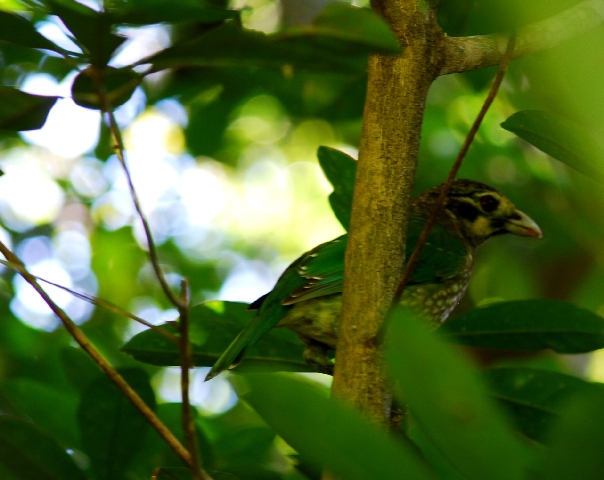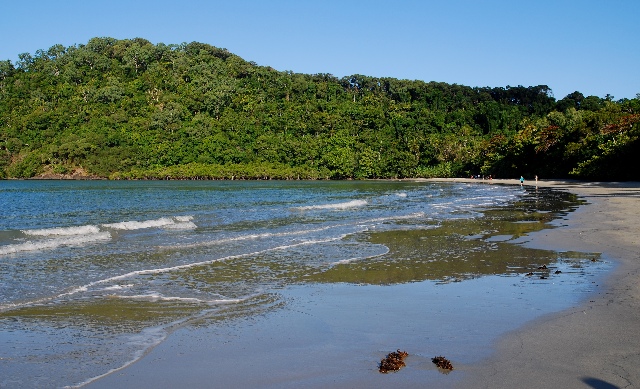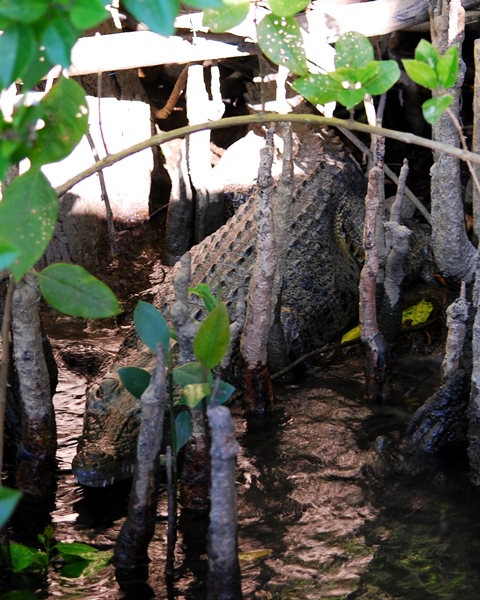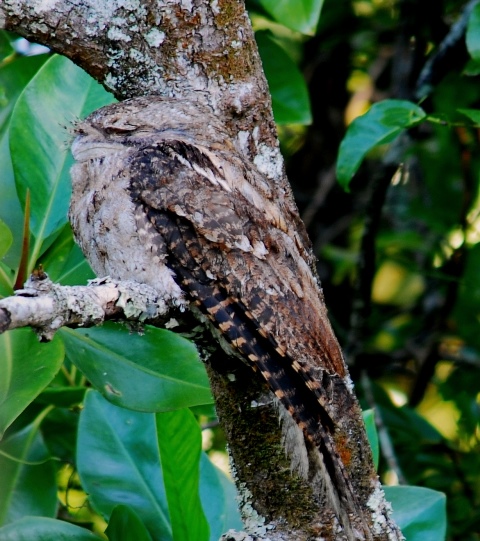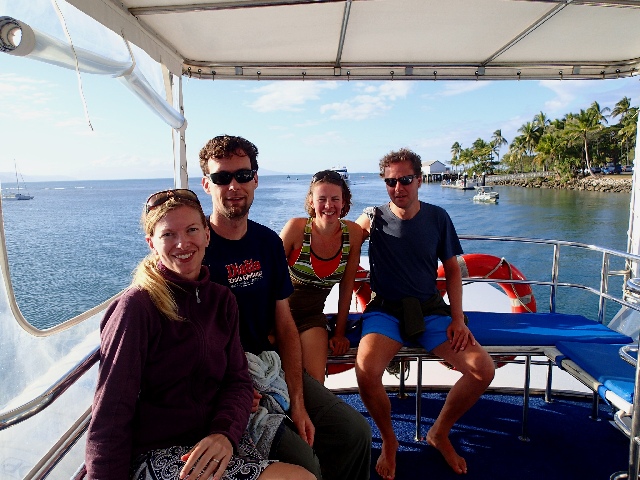Reefs and Rainforests
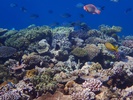 |
August 2015 We started August in the best possible way – with a week-long holiday to the tropical latitudes of Northern Queensland. |
Our adventure started as soon as we flew into Cairns. Within a couple hours of arriving, we were enjoying a wonderful dinner downtown with an old cruising friend, Kevan, who we last saw in Baja California! Kevan was our dock neighbor at Marina Palmira in La Paz, Baja California (where we spent 3 months doing boat work). He ended up selling his beautiful boat, Entres Nous, shortly after we left for mainland Mexico. He wasn’t sure where he was going to end up, but as coincidence has it, he took a job in Cairns! It was wonderful getting to catch up with him and reminisce about Marina Palmira and La Paz.
Hanging out with Kevan, our old marina neighbor from La Paz, Baja California.
The next day, our friends Judith and Ruud arrived (after driving up the coast from Brisbane). They picked us up from the house where we were renting a room for the night, and we drove into Cairns where Judith heard an indigenous art festival was happening. Aboriginal tribes from all over Queensland were gathered in Cairns to demonstrate their art, music and dance. After admiring the artwork, we were treated to a wonderful outdoor dance show by all of the tribes; the dancing was accompanied by didgeridoo and drum players. It was so neat to finally see and learn more about the native culture in Australia. We felt incredibly lucky to have been there at the right time to see this event.
It's neat to see the younger generations learning traditional dances. Hopefully the culture will be kept alive this way!
For the finale, all the tribes came out to dance at once. It was an impressive sight!
Our plan for the rest of the week was to explore the beaches, reefs and rainforests in the area. Prior to our trip though, we had been reading about all the hazards to watch out for in Northern Queensland. Saltwater crocodiles inhabit most creeks and rivers along the coast and they also enjoy swimming in the surf along the beach; highly toxic jellyfish can inhabit the nearshore ocean waters; and if either of these two animals doesn’t get you, sharks frequently patrol the nearshore surf. And of course the most poisonous snakes and spiders in the world live in the rainforest. Thus, heading into this week, I was a bit apprehensive about trying to keep an eye on all the animals that were going to try and kill us.
The beach starts to look less inviting when you see all the warning signs...
We rented a house near Port Douglas, which served as the perfect base for daytrips up and down the coast. At the house, we already started to see wildlife and learned about the crazily eery call of the bush stone-curlew. Our first rainforest hike the next day was to the nearby mountains at Barron Gorge National Park where we tested a couple different trails. Despite our best efforts, we couldn’t find a single snake or spider. But we did see some skinks (a type of lizard), freshwater turtles, and some beautiful rainforest birds. We also learned about the endangered cassowary. This is a large flightless bird that is similar in appearance and size to an emu, except it lives in the rainforest. It just seemed crazy to us that a bird as tall as us could live in such dense foliage! It’s appearance is quite colorful too; Although it’s body is black, it has a long blue neck and head with a bright red goblet hanging off its neck (similar to a turkey) and sports a thick armored crown on the top of its head. Its favorite food is a bright blue plum, called cassowary plum. Unfortunately, due to habitat destruction and highway interactions, there are now estimated to be only 1200 cassowaries left in all of Australia. After learning about the cassowary, we made it our mission for the week to spot one in the wild. After Barron Gorge, the next rainforest hike we did was in Mossman Gorge. The Gorge is a large riverbed filled with massive boulders and surrounded by lush, dense rainforest. It is beautiful, but being a highly advertised tourist destination, it is also packed with people. In many places along the 6K trail we were literally waiting in line to continue walking. Perhaps not unexpectedly, we did not see a cassowary here. Nor any snakes or spiders.
The bush stone-curlew, a bird we saw and heard every night during our stay in Port Douglas. During the day it freezes when anyone approaches, so it looks like a yard ornament (we mistook this guy for one when we came across him). At night though, the bird is quite active and will run incredibly fast on those long legs. At night it also unleashes an incredibly loud wailing, siren-like call. It's a bit unnerving until you realize what it is!
Barron Gorge. Being the dry season, the normally impressive waterfall was running at just a trickle.
Walking along one of the rainforest canopy boardwalks. Thick woody vines are everywhere, as trees use other trees to climb on top of to reach the sunlight. Judith is demostrating her jungle vine swinging abilities!
A common tropical rainforest inhabitant, the fruit dove.
A freshwater turtle we found in a rainforest pond.
Mossman Gorge. The river gorge is quite impressive with its large boulders.
Judith and Ruud hanging out in a large strangler fig. The poor tree surrounded by this fig doesn't stand a chance. You really get a feel for the slow-moving yet aggressive plant world in the rainforest.
After a couple days in the rainforest, we decided to dare death and hang out at the coast for a bit. The beaches north of Cairns and around Port Douglas are gorgeous. Long white sand beaches lined with palm trees. It seems like a cruel evolutionary joke to humans to populate such a beautiful area with so many things that could kill you. However, as we happily soon discovered, in the winter (which it is now) most of the beach threats are at a minimum. Apparently, the ocean water is a bit cold for saltwater crocs at this time of year, and they tend to stay in the shallows of creeks and rivers where they can sunbathe. And beaches where saltwater crocs are known to inhabit are well signed. The box jellies are also only a problem in the summer months when they congregate in the nearshore areas for spawning. So really, the only major threat at this time of year is sharks, which you have to look out for any place you go into the ocean. With our worries mostly absolved, we spent a lovely, relaxing day camped out on Four-Mile Beach in Port Douglas. When the sun got too warm, we went for a refreshing dip in the ocean where nothing attacked us. This is the life!
The beautiful beaches around Port Douglas.
Spending a relaxing day at the beach.
And we even got in the water for a swim and nothing attacked us! :)
Since we survived the rainforest and the beach, our next adventure was to finally see the Great Barrier Reef (we’ve lived in Australia over eight months now and have yet to see it). One thing we learned when we were at the beach, is that the reef is not close to shore, as we were used to from the other islands we’ve visited. The Great Barrier Reef actually lies about 20 miles offshore, on the continental shelf of northern Australia. So to see the reef, you have to take a boat. As our boat was some distance away in Brisbane, we opted for a snorkel cruise to the outer reefs. There are many tour boat operators and some have massive cruise ship style boats that hold hundreds of people. We decided we’d rather see the reef and not other people, so we went with a smaller boat which took us to three different sites along the outer reefs. Despite having already seen magnificent reefs in the Tuamotus and Fiji, the outer reefs of the GBR really lived up to their hype and were spectacular. The water was incredibly clear and it felt like we were swimming in an aquarium. The coral diversity was excellent. We also saw gorgeous giant clams with mantles of mottled green, blue, and brown, bevies of colorful reef fishes, including a large humphead wrasse, and brilliant green anemones with their resident clownfish.
The snorkel boat.
The reef.
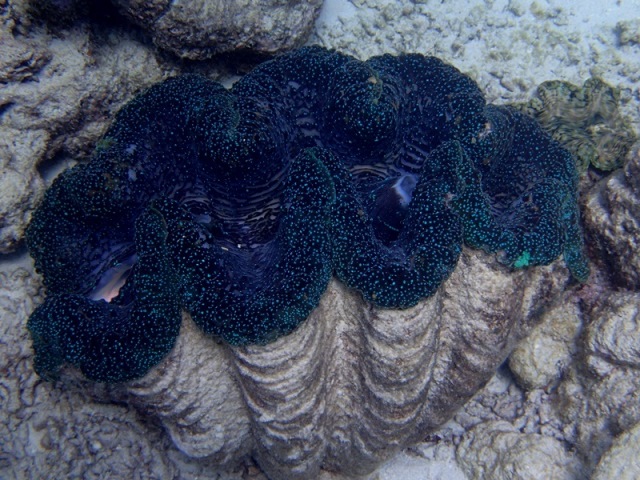
A giant clam
Angus the humphead wrasse.
The requisite clownfish hanging out in its anemone picture.
After our amazing day on the GBR, we had two more days before Chris and I flew back to Brisbane. We decided to spend our last days exploring the world’s oldest living rainforest, the Daintree. Plants in the Daintree rainforest have characteristics of prehistoric plants from over 20 million years ago. It is a place where time really does appear to have stopped. Surely we could spot a cassowary here! :)
The Daintree rainforest is beautiful – it seemed more lush and full of life than the rainforests we’d been hiking in earlier in the week. Although, part of this impression could be from the fact that we could hear more of the birds since the trails didn’t have the throngs of people we saw at Mossman Gorge. Along several trails we spotted the cassowary’s favorite food, the purple cassowary plum. We also found multiple piles of cassowary scat along the trails. But alas, despite scanning the forest continually, we could see no actual cassowary. They are very good at hiding! We did see and hear numerous other birds though, and thoroughly enjoyed being enveloped in the glowing green life of the forest.
One of my favorite rainforest trees, the fan palm.
The cassowary plum.
Everything grows on top of each other in the rainforest. Most tree trunks are decorated with the vines of other plant species.
A spotted catbird. This bird has an interesting call that is remarkably like a cat yowling.
The beautiful beach at Cape Tribulation, as far north as we could travel by car in the Daintree rainforest.
Our final stop before heading back to Brisbane was at the Daintree River. Christian had a strong desire to see the terrible man-eater we’d been trying to avoid, the saltwater crocodile. Luckily, there are several relatively inexpensive jungle cruises you can take to see the massive reptiles from the safety of a boat. The drivers are quite good at spotting the well-camouflaged crocs, and found us several crocs basking in the shallow water of the river – definitely not a place you’d want to go swimming!
The Daintree River.
A croc hanging out by the riverbank.
Our jungle cruise driver spotted this well camouflaged bird in the trees, a frogmouth.
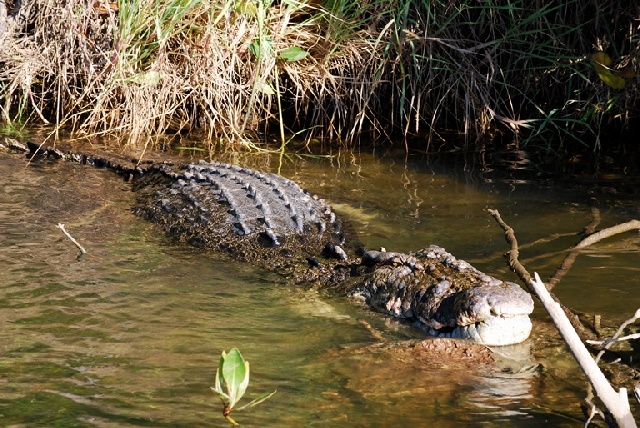
The largest crocodile we spotted, called "Scarface" by locals. He is estimated to be close to 70 years old!
Too soon our adventure came to an end. Judith and Ruud hit the road again and we boarded our flight back to Brisbane. It was an amazing week made all the better by getting to share it with old friends.
We had a great week exploring the Cairns region with our friends Judith and Ruud who were visiting from the Netherlands.
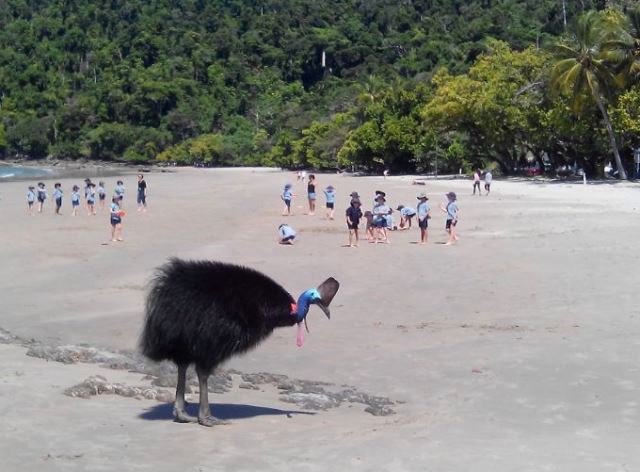
The elusive cassowary. Judith and Ruud finally spotted one at the beach no less, south of Cairns! (Picture courtesy of Judith Jobse)

